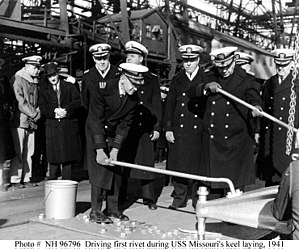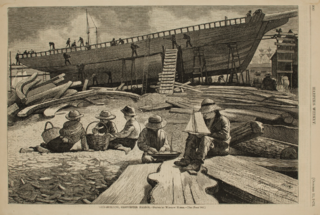
Shipbuilding is the construction of ships and other floating vessels. It normally takes place in a specialized facility known as a shipyard. Shipbuilders, also called shipwrights, follow a specialized occupation that traces its roots to before recorded history.
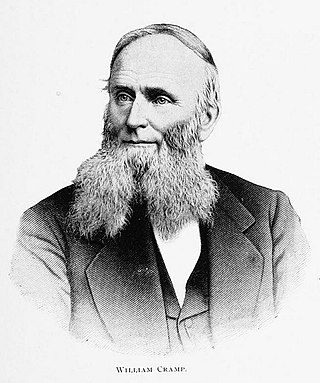
William Cramp & Sons Shipbuilding Company was an American shipbuilding company based in Philadelphia, Pennsylvania, founded in 1830 by William Cramp. During its heyday in late 19th century, it was the preeminent American iron shipbuilder.
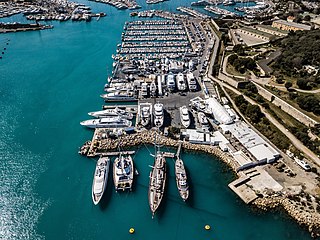
A shipyard, also called a dockyard or boatyard, is a place where ships are built and repaired. These can be yachts, military vessels, cruise liners or other cargo or passenger ships. Compared to shipyards, which are sometimes more involved with original construction, dockyards are sometimes more linked with maintenance and basing activities. The terms are routinely used interchangeably, in part because the evolution of dockyards and shipyards has often caused them to change or merge roles.

Charleston Naval Shipyard was a U.S. Navy ship building and repair facility located along the west bank of the Cooper River, in North Charleston, South Carolina and part of Naval Base Charleston.

USS Gerald R. Ford (CVN-78) is an aircraft carrier for the United States Navy and the lead ship of her class. The ship is named after the 38th President of the United States, Gerald Ford, whose World War II naval service included combat duty aboard the light aircraft carrier Monterey in the Pacific Theater.
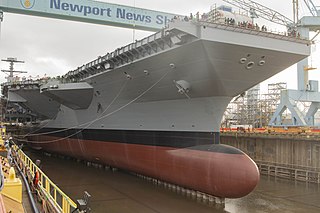
USS John F. Kennedy (CVN-79) is the second Gerald R. Ford-class aircraft carrier built for the United States Navy. She was launched on 29 October 2019, and christened on 7 December 2019.

MILGEM project (Turkish:Milli Gemi Projesi, English: National Ship Project) is a national warship program of the Republic of Turkey. Managed by the Turkish Navy, the project aims at developing multipurpose corvettes, frigates and destroyers that can be deployed in a range of missions, including reconnaissance, surveillance, early warning, anti-submarine warfare, surface-to-surface and surface-to-air warfare, and amphibious operations.
The coin ceremony is an event which takes place at the keel laying, in the early stages of a ship's construction. In it, the shipbuilders place one or two coins under the keel block of the new ship to bless the ship and as a symbol of good fortune. The coins are not normally fixed in place and are often retrieved when the ship sails out of the dry-dock,.

Brodosplit is the largest shipyard in Croatia, located in the Supaval bay, on the north side of the Split peninsula.

The Makassar class is a class of South Korean-designed Landing Platform Dock. The lead ship is named after the city of Makassar in Sulawesi and built in Busan, South Korea. The ships were designed by Daesun Shipbuilding & Engineering Co. based on their earlier design of Tanjung Dalpele class that was sold to the Indonesian Navy.

The Karachi Shipyard & Engineering Works Limited is a major defence contractor and shipbuilding company situated in the West Wharf in Karachi, Sindh in Pakistan.

Harry DeWolf-class offshore patrol vessels are warships of the Royal Canadian Navy (RCN) built within the Government of Canada Arctic and Offshore Patrol Ship (AOPS) procurement project, part of the National Shipbuilding Strategy. In July 2007 the federal government announced plans for acquiring six to eight icebreaking warships for the RCN.

Mast stepping is the process of raising the mast of a boat. It may be a ceremonial occasion on a new boat, a necessary step, or simply routine.
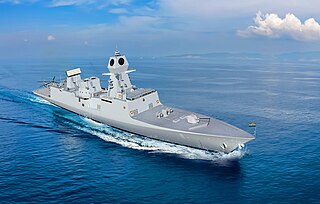
The Nilgiri-class frigates, formally classified as the Project-17 Alpha frigates (P-17A), are a series of stealth guided-missile frigates currently being built by Mazagon Dock Shipbuilders (MDL) and Garden Reach Shipbuilders & Engineers (GRSE), for the Indian Navy. The seventh and final ship of the Project 17A frigates, named Mahendragiri, was launched on 1 September 2023 at the Mazagon Dock by Dr Sudesh Dhankhar, wife of Indian vice-president Jagdeep Dhankhar. It is expected to be commissioned in 2024.

The Samuel Beckett-class offshore patrol vessel is a class of offshore patrol vessels (OPV) ordered by the Irish Naval Service from October 2010. The first vessel is named Samuel Beckett and was commissioned in May 2014. Construction on this first vessel commenced in November 2011, A further three vessels were named James Joyce, William Butler Yeats and George Bernard Shaw, and delivered in 2015, 2016 and 2018 respectively.

The Gremyashchiy class, Russian designation Project 20385, is an update of the Steregushchiy-class corvettes of the Russian Navy at a cost of 150 million $. This follow-on project was designed by the Almaz Central Marine Design Bureau in Saint Petersburg. The first ship was laid down on 26 May 2011 and the official laying down ceremony took place on 1 February 2012. Although classified as corvettes by the Russian Navy, these ships carry sensors and weapon systems akin to frigates and, as a result, are so classified by NATO.

USS Enterprise (CVN-80) will be the third Gerald R. Ford-class aircraft carrier to be built for the United States Navy. She will be the ninth United States naval vessel and third aircraft carrier to bear the name, and is scheduled to be in operation by 2028. Her construction began in August 2017 with a steel-cutting ceremony.

The Anti-Submarine Warfare Shallow Water Craft (ASW-SWC) corvettes, are a class of anti-submarine warfare (ASW) vessels currently being built for the Indian Navy, by Cochin Shipyard (CSL) and Garden Reach Shipbuilders & Engineers (GRSE). They were conceived as a replacement to the ageing Abhay-class corvettes of the Indian Navy, and are designed to undertake ASW duties – including subsurface surveillance in littoral waters, search-and-attack unit (SAU) missions and coordinated anti-submarine warfare operations with naval aircraft. They were also designed to provide secondary duties – including defense against intruding aircraft, minelaying and search-and-rescue (SAR).
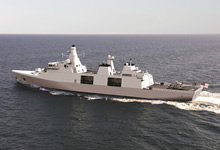
The Type 31 frigate, also known as the Inspiration class, and formerly known as the Type 31e frigate or General Purpose Frigate (GPF), is a class of five frigates being built for the United Kingdom's Royal Navy, with variants also being built for the Indonesian and Polish navies. The Type 31 is intended to enter service in the 2020s alongside the eight submarine-hunting Type 26 frigate and will replace the five general-purpose Type 23 frigates. The Type 31 is part of the British government's "National Shipbuilding Strategy".
The Hangor-class submarines are a class of diesel–electric attack submarines currently being manufactured by a joint-partnership of the China Shipbuilding Industry Corporation (CSIC) and the Karachi Shipyard & Engineering Works (KSEW) for the Pakistan Navy (PN). Eponymously christened after the former-Daphné-class submarines that the PN operated between 1970 and 2006, the class is an export derivative of the Chinese-origin Type 039A/041 attack submarine, currently operated by the People's Liberation Army Navy (PLAN). First unveiled to the public in 2018, the future submarines are envisaged to undertake anti-access/area denial operations within Pakistan's exclusive economic zone, through the use of heavyweight torpedoes and anti-ship cruising missiles.
